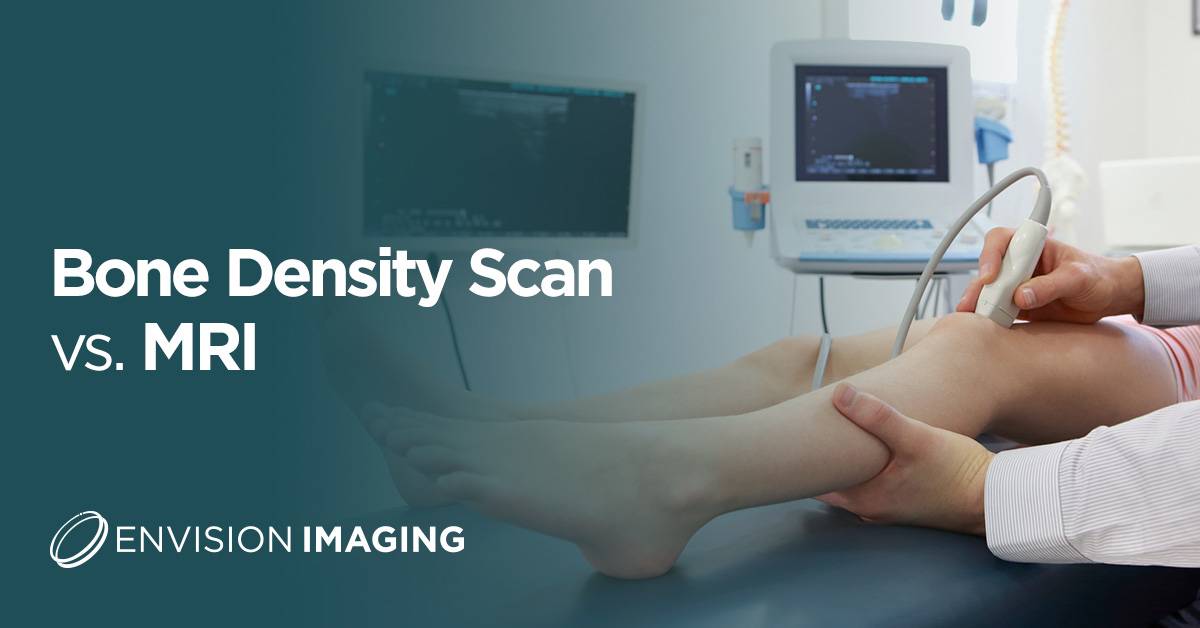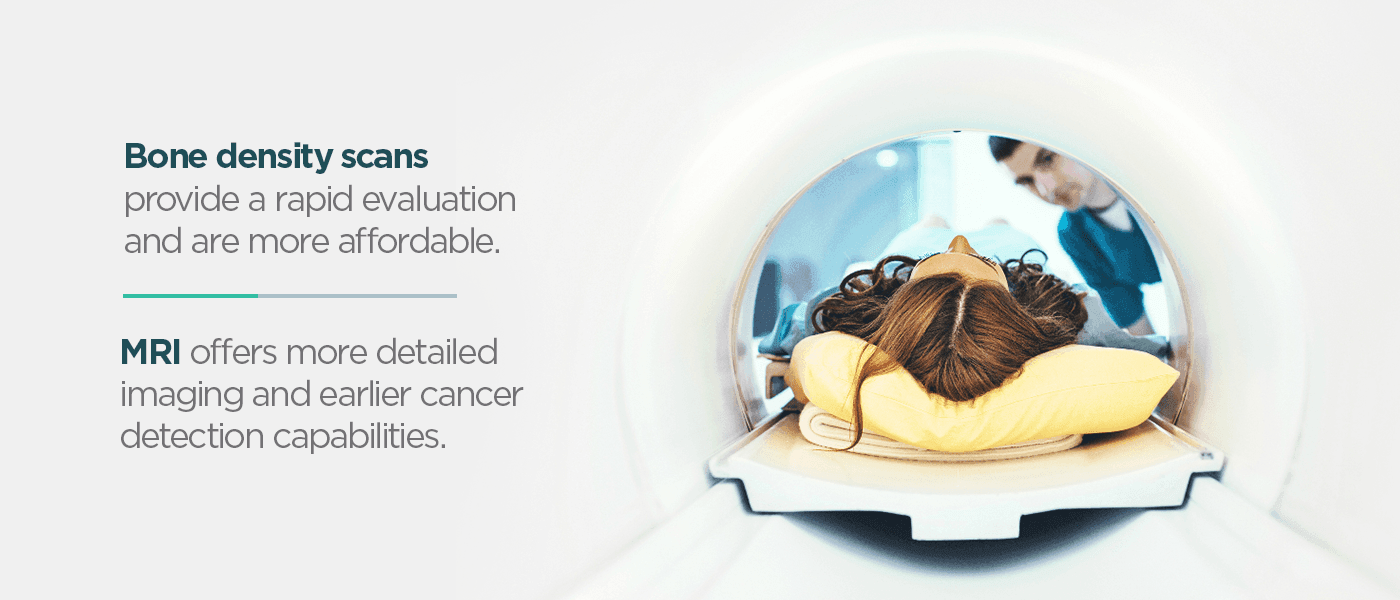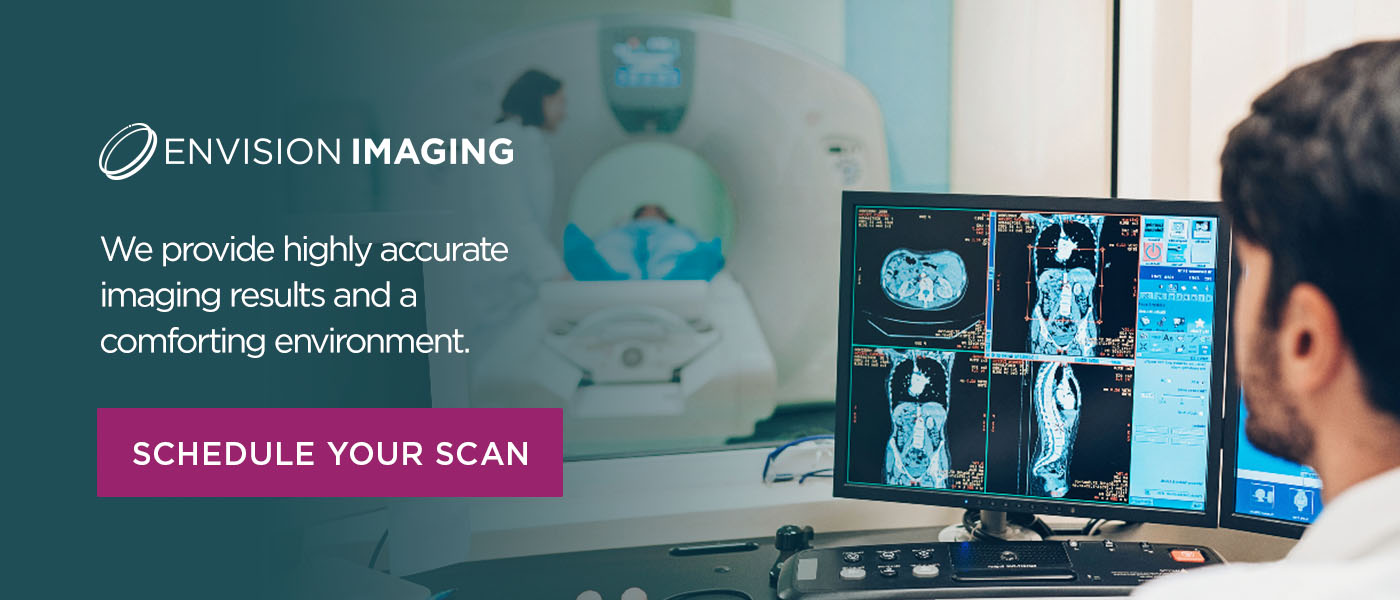Bone Density Scan vs. MRI
If your health care team has told you bone imaging is necessary to help identify and treat a health condition, you may be wondering whether you will need a bone density scan or an MRI. These two tools are critical for providing a detailed image of bone health and identifying bone diseases.
To understand the benefits of each scan, read on about how each of these imaging modalities functions and which option fits specific applications best.
What situations require a bone scan or MRI?
Your unique needs will determine whether you require a bone scan or an MRI, as the two tests have some crucial differences. Traditionally, bone scans were the preferred option to evaluate patients experiencing bone pain or other symptoms that might suggest bone disease or infection. However, recent studies have demonstrated that MRIs are highly effective for accurately detecting bone infections, cancers and other related conditions.
MRI bone scan
Magnetic resonance imaging technology operates by using radiofrequency and magnetic fields to develop images of the inside of the body. Technologists can analyze a specific area by creating 3D images to represent internal organs and structures accurately. The detailed pictures this tool yields can facilitate rapid and accurate assessment of the targeted area to identify bone cancer.
Bone scans
Bone scans, also known as bone scintigraphy, use radioactive tracers to develop images of the bones. One essential capability of the technology is detecting osteoblast formation. Using the tracers, bone scans can locate these signs of damage and healing. Once they identify osteoblasts, technologists can pinpoint the bone tumor’s location.
Applications of bone scan vs. MRI for cancer
For cancer and other bone infections and conditions, bone scans and MRI can provide valuable analysis. However, their capabilities for imaging vary slightly between scan types.
Bone scan
Because they can rapidly detect osteoblasts as an indicator of bone disease, bone scans are an optimal way to identify bone infections.
If you experience daily bone pain anywhere in your body, a bone scan can quickly find its source. Its ability to detect osteoblasts helps it accurately locate areas of bone damage, identifying minor infections, fractures and other potential issues as early as possible. With a bone scan, your doctor can pinpoint the underlying reasons for bone pain and help you find the right treatment plan.
Able to identify complex bone structures, this technology can detect several other types of bone conditions:
- Metastisized cancer cells in the bone
- Osteoporosis
- Bone damage caused by infection
MRI
When your doctor needs a more detailed image of a bone area, an MRI may be the best option. Its capabilities for 3D image generation allow an MRI to pinpoint internal conditions such as cancer earlier. This technology allows your doctor to get a highly accurate analysis of potential problem areas so you can begin targeted treatment sooner.
When choosing between a bone scan versus MRI for cancer detection, providers typically prefer an MRI. Because MRIs can reveal abnormal appearance or physical abscess in bones, they are more effective at detecting bone cancer than traditional bone scans. They can also identify cancer earlier than bone scans can, allowing MRIs to detect the disease before cancer reaches the bones.
Additional bone conditions MRIs can accurately detect include:
- Osteomyelitis
- Bone marrow disease
- Tumors
- Herniation
- Congenital abnormalities
- Osteonecrosis
- Inflammatory disease
DEXA scan vs. MRI and bone scan
A dual-energy x-ray absorptiometry scan can help your doctors assess your bone density and overall health. This tool is different from a bone scan because it does not use radioactive tracing but instead relies on x-ray imaging. Most likely, your doctor will recommend a DEXA scan if you may have osteoporosis. It focuses on testing density rather than overall target area imaging like an MRI would provide.
Benefits of bone scans vs. MRI for cancer and other conditions
Your doctor can work with you to determine the ideal imaging option for your specific needs. Choosing a nuclear bone scan vs. an MRI will provide different advantages that may fit your unique situation and health diagnostic needs.
Bone scans can provide a rapid evaluation to pinpoint the cause of bone pain in the body. This option is also more affordable, making it more accessible for exploring an unknown cause of bone pain.
If your doctor wants to assess potential bone cancer, an MRI offers the distinct advantage of more detailed imaging and earlier cancer detection capabilities. Depending on your situation, these benefits may be critical to developing the best treatment plan for you.
How to prepare for scans
If you’re going in for a bone scan or MRI scan, you can remember some best practices to help you get ready and stay as comfortable as possible for the procedure. As you prepare for the process, you typically won’t need to make significant changes to your daily routine. Whether you’re getting an MRI, bone scan or DEXA scan, you can eat and drink as usual unless you receive specific instructions from your doctor.
When you arrive for your appointment, you can expect to answer questions about your family history, overall health, current medications and smoking history. Take these steps before your test.
- Avoid wearing any metal: Plan your outfit to avoid metal items such as zippers or buckles, and don’t wear metal jewelry if possible.
- Wear loose-fitting clothing: To help make the procedure more comfortable, wear loose-fitting, comfortable clothing.
- Tell your technologist if you might be pregnant: Bone scans use low levels of radiation, so you’ll want to ensure your health care providers are aware you might be pregnant. A potential pregnancy will not be a concern for MRIs, as they do not use radiation.
Trust Envision Imaging for your bone scan or MRI imaging needs
At Envision Imaging, our goal is to offer world-class diagnostic imaging solutions for each of our patients. We provide the highest-quality MRI scans, CAT scans and other radiology services to help patients and physicians develop optimized treatment plans. When you trust us for your imaging needs, we provide compassionate care, highly accurate imaging results and a comforting environment.
You can rely on our responsive, flexible scheduling and rapid-result turnaround times. Our goal is to offer caring, expert service from the moment our patient receives a referral. We understand that each patient navigates unique circumstances when they visit our facility. Our staff prioritizes creating a pleasant experience that helps our patients feel safe and reassured.
We accept most insurance plans and strive to provide excellent services at affordable costs.
Browse our locations to request your next diagnostic imaging appointment. Our world-class facilities, compassionate care and accurate results ensure a pleasant and reliable experience.
Sources:
https://pubmed.ncbi.nlm.nih.gov/12357066/
https://www.ncbi.nlm.nih.gov/pmc/articles/PMC1495160/
https://www.ncbi.nlm.nih.gov/pmc/articles/PMC4239579/
https://www.envrad.com/locations/
https://www.pbmchealth.org/news-events/blog/bone-scan-vs-mri-whats-best-imaging-tool
https://www.medicinenet.com/is_a_bone_scan_the_same_as_an_mri/article.htm
https://my.clevelandclinic.org/health/diagnostics/10683-dexa-dxa-scan-bone-density-test




